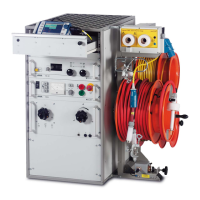
Do you have a question about the Baur Syscompact 2000 and is the answer not in the manual?
| Brand | Baur |
|---|---|
| Model | Syscompact 2000 |
| Category | Test Equipment |
| Language | English |
Legal notice regarding reproduction and modification of publication content.
Introduction to the manual's purpose and scope for correct system handling and operation.
Specifies that the Syscompact 2000 is for authorized personnel and adherence to safety regulations.
Details BAUR's commitment to repair or replace faulty parts within 12 months of delivery.
Lists the various methods used by the Syscompact 2000 for cable fault prelocation.
Explains the principle of TDR for detecting cable interruptions and shorts using impulse reflection.
Describes the SIM method using low and high voltage impulses to locate faults via negative reflections.
Details the ICM method which uses transient waves generated by impulses to locate faults.
Identifies and labels the components visible on the front panel of the Syscompact 2000 system.
Identifies and labels the connections and inputs/outputs on the rear panel of the system.
Details the SA 32's capabilities for SIM/MIM methods, DC testing, and its integrated milliammeter.
Describes the SA 32K variant, noting its lack of solid earthing and milliammeter, used for extended pulse periods.
Explains the CS 32/2's function as an HV connector with safety features and low voltage sockets.
Describes the KTG M3 rack holding mains, earth, and high voltage cables on lockable drums.
Refers to the IRG 2000 user manual for connection details and operational procedures.
Provides critical safety and operational guidelines before using the Syscompact 2000 system.
Details the correct procedure for using the discharge and grounding rod for safety.
Outlines the preparation of the DUT and connection of the safety earth line.
Step-by-step instructions for safely activating and deactivating the high voltage output.
Explains how to use the TDR method for identifying short cuts, interruptions, and cable ends.
Guides on using the SIM-MIM method for high-resistance and intermittent faults, including echogram analysis.
Details the application of SIM-MIM with DC voltage for intermittent faults and flash-over events.
Explains the ICM/Surge Method for locating faults greater than 100 Ohms and wet faults.
Instructions for periodic checking and adjustment of the spark gap's breakdown voltage.
Procedure for periodically checking the discharge unit's resistance for safety before operation.
Describes an optional external emergency-off button for performing tests safely in any location.